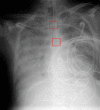Image augmentation and automated measurement of endotracheal-tube-to-carina distance on chest radiographs in intensive care unit using a deep learning model with external validation
- PMID: 36698191
- PMCID: PMC9878756
- DOI: 10.1186/s13054-023-04320-0
Image augmentation and automated measurement of endotracheal-tube-to-carina distance on chest radiographs in intensive care unit using a deep learning model with external validation
Abstract
Background: Chest radiographs are routinely performed in intensive care unit (ICU) to confirm the correct position of an endotracheal tube (ETT) relative to the carina. However, their interpretation is often challenging and requires substantial time and expertise. The aim of this study was to propose an externally validated deep learning model with uncertainty quantification and image segmentation for the automated assessment of ETT placement on ICU chest radiographs.
Methods: The CarinaNet model was constructed by applying transfer learning to the RetinaNet model using an internal dataset of ICU chest radiographs. The accuracy of the model in predicting the position of the ETT tip and carina was externally validated using a dataset of 200 images extracted from the MIMIC-CXR database. Uncertainty quantification was performed using the level of confidence in the ETT-carina distance prediction. Segmentation of the ETT was carried out using edge detection and pixel clustering.
Results: The interrater agreement was 0.18 cm for the ETT tip position, 0.58 cm for the carina position, and 0.60 cm for the ETT-carina distance. The mean absolute error of the model on the external test set was 0.51 cm for the ETT tip position prediction, 0.61 cm for the carina position prediction, and 0.89 cm for the ETT-carina distance prediction. The assessment of ETT placement was improved by complementing the human interpretation of chest radiographs with the CarinaNet model.
Conclusions: The CarinaNet model is an efficient and generalizable deep learning algorithm for the automated assessment of ETT placement on ICU chest radiographs. Uncertainty quantification can bring the attention of intensivists to chest radiographs that require an experienced human interpretation. Image segmentation provides intensivists with chest radiographs that are quickly interpretable and allows them to immediately assess the validity of model predictions. The CarinaNet model is ready to be evaluated in clinical studies.
Keywords: Chest radiograph; Deep learning; Image processing; Intensive care unit; RetinaNet.
© 2023. The Author(s).
Conflict of interest statement
The authors declare that they have no competing interests
Figures









Similar articles
-
Validation of a Deep Learning-based Automatic Detection Algorithm for Measurement of Endotracheal Tube-to-Carina Distance on Chest Radiographs.Anesthesiology. 2022 Dec 1;137(6):704-715. doi: 10.1097/ALN.0000000000004378. Anesthesiology. 2022. PMID: 36129686
-
Identification and Localization of Endotracheal Tube on Chest Radiographs Using a Cascaded Convolutional Neural Network Approach.J Digit Imaging. 2021 Aug;34(4):898-904. doi: 10.1007/s10278-021-00463-0. Epub 2021 May 23. J Digit Imaging. 2021. PMID: 34027589 Free PMC article.
-
Artificial Intelligence for Assessment of Endotracheal Tube Position on Chest Radiographs: Validation in Patients From Two Institutions.AJR Am J Roentgenol. 2024 Jan;222(1):e2329769. doi: 10.2214/AJR.23.29769. Epub 2023 Sep 13. AJR Am J Roentgenol. 2024. PMID: 37703195
-
Role of ultrasound in confirmation of endotracheal tube in neonates: a review.J Matern Fetal Neonatal Med. 2019 Apr;32(8):1359-1367. doi: 10.1080/14767058.2017.1403581. Epub 2017 Nov 22. J Matern Fetal Neonatal Med. 2019. PMID: 29117819 Review.
-
Machine Vision and Image Analysis in Anesthesia: Narrative Review and Future Prospects.Anesth Analg. 2023 Oct 1;137(4):830-840. doi: 10.1213/ANE.0000000000006679. Epub 2023 Sep 5. Anesth Analg. 2023. PMID: 37712476 Free PMC article. Review.
Cited by
-
Clinical Implementation of an Artificial Intelligence Tool in the Detection and Management of Pneumothoraces in Patients With COVID-19.Cureus. 2023 Jul 26;15(7):e42509. doi: 10.7759/cureus.42509. eCollection 2023 Jul. Cureus. 2023. PMID: 37637593 Free PMC article.
-
Recommendations for the creation of benchmark datasets for reproducible artificial intelligence in radiology.Insights Imaging. 2024 Oct 14;15(1):248. doi: 10.1186/s13244-024-01833-2. Insights Imaging. 2024. PMID: 39400639 Free PMC article.
-
The Future of Artificial Intelligence Using Images and Clinical Assessment for Difficult Airway Management.Anesth Analg. 2025 Feb 1;140(2):317-325. doi: 10.1213/ANE.0000000000006969. Epub 2025 Jan 10. Anesth Analg. 2025. PMID: 38557728 Free PMC article. Review.
-
What Is Machine Learning, Artificial Neural Networks and Deep Learning?-Examples of Practical Applications in Medicine.Diagnostics (Basel). 2023 Aug 3;13(15):2582. doi: 10.3390/diagnostics13152582. Diagnostics (Basel). 2023. PMID: 37568945 Free PMC article. Review.
References
-
- Colin C. Prise en charge des voies aériennes en anesthésie adulte à l’exception de l’intubation difficile. Annales Françaises d’Anesthésie et de Réanimation. 2003;22:3–17. doi: 10.1016/S0750-7658(03)00127-8. - DOI
MeSH terms
LinkOut - more resources
Full Text Sources

